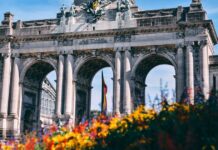Solemn prayers and speeches rang out inside the Golden Temple in Amritsar, the holiest of sites in the Sikh religion, as the northern state of Punjab marked the 40th anniversary of a deadly Indian military operation. Operation Blue Star, as it was called, left hundreds dead and damaged the temple’s inner shrine.
At the same time, a group of about 200 supporters of an independent Sikh state called Khalistan were gathered in the corner of the temple’s compound, chanting slogans and declaring that the “Sikh religious flag is flying high.”
“Sikhs cannot forget this day,” said 27-year-old student Harmandeep Singh after the Thursday ceremony. “The day on which our [inner shrine] was attacked.”
The military siege in June 1984 was ordered by India’s then-prime minister Indira Gandhi. The aim was to flush out militant separatist Sikh leader Jarnail Singh Bhindranwale and his armed followers, barricaded inside the Golden Temple, and stifle the burgeoning Khalistan movement for an independent homeland.

Official figures put the death toll at around 400 people. Sikh groups dispute that figure and say the number of people that died was in the thousands.
Gandhi would later be assassinated by her Sikh bodyguards in apparent retaliation for the bloodshed at the temple. That, in turn, triggered days of anti-Sikh riots across India during which several thousand people died. The deadly incident also sparked years of violence and turmoil in Punjab.
Bitter feelings linger
The bitterness and rancour over the attack within India’s Sikh community remains strong 40 years later, even among the younger generation.
“The Indian state attacked a pilgrimage temple — a place of peace,” said student Manmohan Singh, 24.
“They used tanks, helicopters, commandos. Full [force]. To kill Sikhs,” added his friend, Harmandeep Singh, who had travelled from the Punjab town of Moga, more than 100 kilometres away, for the ceremony.
“Why was that needed, that police would enter into that premises?”

Satpal Singh Danish, 75, was a photojournalist in Amritsar at the time and documented the days-long armed forces raid after first shots were fired on June 1, 1984.
It was hard to gauge how many army officers were surrounding the temple in the days preceding the attack because they were scattered in different locations, he told CBC News.
But when the military stormed inside, it suddenly became very clear.
“I realized that this was a war,” he said. The fear in the city was intense, the photographer recalled, especially when the reality hit the residents that the military operation was “an attack on a religious place … that cannot be erased.”
For Beant Singh, 81, whose brother was killed inside the temple during the military assault, the yearly commemoration ceremonies are increasingly difficult to attend because of his age.
But the pain associated with Operation Blue Star will never fade, he said in an interview.

Singh’s brother, Sabeg Singh, was a former general in the Indian army who was suspended and subsequently became close to the militant Sikh leaders.
“We weren’t even allowed to see [my brother’s] body, and the government didn’t give us his belongings,” Singh said.
“This is a huge black mark on Indira Gandhi and the Indian government,” he said. His community “will never forgive” the government, he added.
Discrimination continues
Forty years after Indian armed forces stormed the Golden Temple, there was a sense among some of those who gathered for the Thursday ceremonies — held annually on June 6 to commemorate the main day of the assault — that the current government, under newly re-elected Prime Minister Narendra Modi, is continuing the discrimination against Sikhs.
“There is not much difference between the government of Indira Gandhi and the current government,” said student activist Harshwinder Singh, 19.
Singh believes there is a double standard when it comes to nationalist rhetoric from the Hindu majority compared to the minority Sikh community, which make up 1.7 per cent of the population of India but are the majority in Punjab state.
“Prime Minister Narendra Modi and other leaders, they are directly talking about Hindu Rashtra on the stage,” Singh said, referring to the ruling BJP party’s rhetoric about India as a Hindu nation first. “And nothing happens to them. But if the Sikhs ask for Khalistan, they are sent to jails.”
He means Amritpal Singh, a self-styled preacher and Khalistani activist who has fashioned himself as a successor to Bhindranwale, the Sikh leader killed during Operation Blue Star.
Amritpal Singh was the subject of a weeks-long manhunt in April 2023, before being caught and jailed. He ran as an independent in the recent Indian general election from his jail cell and won a seat.
The son of one of Indira Gandhi’s assassins, Sarabjeet Singh Khalsa, also secured a seat in India’s Parliament.
On the streets of Punjab, many Sikhs reject the idea of a separate Khalistan and fear the idea is being exaggerated on social media. CBC’s South Asia correspondent Salimah Shivji breaks down why.
But for others, the ceremony to commemorate Operation Blue Star is about educating future generations, and not about politics.
“We have to remember,” said newlywed Prableen Kaur, visiting Amritsar from India’s capital Delhi. “To not let it happen again.”
She said it’s especially important under an Indian government that doesn’t always show regard for its religious minorities.
“Sikhs are still a minority in this country and you never know in this nation.”
Published at Sun, 09 Jun 2024 08:00:00 +0000
Israeli military bombards central Gaza as Palestinian death toll in hostage rescue raid rises
Israeli forces pounded central Gaza anew on Sunday — a day after the enclave’s health ministry says 274 Palestinians were killed during a hostage rescue raid — as tanks advanced further into areas of Rafah in an apparent bid to seal off part of the southern city.
Palestinians remained in shock over Saturday’s death toll, the worst over a 24-hour period of the Gaza war for months and including many women and children, Palestinian medics said.
In an update on Sunday, Gaza’s health ministry said 274 Palestinians were killed — up from 210 it reported on Saturday — and 698 were injured when Israeli special force commandos stormed Nuseirat in central Gaza to rescue four hostages held since October by Hamas militants.
Sixty-four of the dead were children and 57 were women, the Hamas-run Gaza government media office said on Sunday.
Israel’s military said a special forces officer was killed in exchanges of fire with militants emerging from cover in residential blocks, and that it knew of “under 100” Palestinians killed, though not how many of them were fighters or civilians.
Israel’s military says it rescued four hostages — Noa Argamani, 26, Almog Meir Jan, 21, Andrey Kozlov, 27, and Shlomi Ziv, 40 — who had been held by Hamas for eight months during a raid in central Gaza on Saturday. Dozens of Palestinians were reported killed amid Israel’s heavy air and ground assault, Gaza health officials said.
On Sunday, three Palestinians were killed and several hurt in an Israeli airstrike on a house in Bureij in the central Gaza Strip, while tanks shelled parts of nearby Maghazi and Nuseirat. All are built-up, historic refugee camps.
The Israeli military said in a statement its forces were continuing operations east of Bureij and the city of Deir al-Balah in the centre of the coastal enclave, killing several Palestinian gunmen and destroying militant infrastructure.
Israel sent forces into Rafah in May in what it called a mission to wipe out Hamas’s last intact combat units after eight months of war, in which Israeli forces have bombed much of the rest of Gaza to rubble while advancing against fierce resistance from militants embedded in crowded cities and built-up camps.
Israeli tank forces have since seized Gaza’s entire border strip with Egypt running through Rafah to the Mediterranean coast and invaded several districts of the city, prompting around one million displaced people who had been sheltering in Rafah to flee elsewhere.
UNRWA shelters vacated
On Sunday, tanks advanced into two new districts in an apparent effort to complete the encirclement of the entire eastern side of Rafah, touching off clashes with dug-in Hamas-led armed groups, according to residents trapped in their homes.
As of June 5, all but around 100,000 displaced people who took refuge in eastern Rafah after taking flight from Israeli offensives further north in Gaza had left, according to the UN agency for Palestinian refugees UNRWA.
“All UNRWA shelters in Rafah have been vacated. Many of the people who were based in Rafah have fled up the coast seeking safer locations in both Khan Younis and the middle area [of Gaza],” UNRWA said in a statement.
Palestinian medics said an Israeli airstrike on a house in Tel Al-Sultan in western Rafah killed two people.
The Israeli military said troops of its 162nd division were raiding some districts of Rafah where they had located “numerous additional terror tunnel shafts, mortars, and [other] weapons” belonging to Palestinian Islamist militants.
A massive pro-Palestinian demonstration packed the streets of central London on Saturday as protesters marched from Russell Square to the Houses of Parliament. They passed a smaller counter-demonstration of less than 100 pro-Israel supporters who blared dance music and waved Israeli and British flags.
Hamas precipitated the war with a cross-border attack into Israel last Oct. 7, killing around 1,200 people and seizing over 250 hostages, according to Israeli tallies. About half the hostages were freed during a brief November truce.
Israel’s ensuing air and ground war has killed at least 37,084 Palestinians, Gaza’s health ministry said in its Sunday update. The ministry says thousands more dead are feared buried under the rubble.
Attempts by the United States and regional countries to broker a deal that would release all remaining hostages in return for a ceasefire have repeatedly stumbled on Israeli and Hamas intransigence over terms for an end to the war.
Gaza’s conflict has destabilized the wider Middle East, drawing in Hamas’s main backer Iran and its Lebanese ally Hezbollah which has been clashing with Israel along its northern border for months, raising fears of all-out war.
Published at Sun, 09 Jun 2024 13:40:12 +0000










